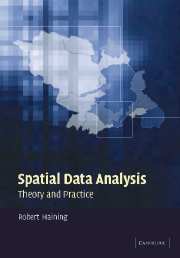Book contents
- Frontmatter
- Contents
- Preface
- Acknowledgements
- Introduction
- Part A The context for spatial data analysis
- Part B Spatial data: obtaining data and quality issues
- Part C The exploratory analysis of spatial data
- Part D Hypothesis testing and spatial autocorrelation
- Part E Modelling spatial data
- 9 Models for the statistical analysis of spatial data
- 10 Statistical modelling of spatial variation: descriptive modelling
- 11 Statistical modelling of spatial variation: explanatory modelling
- Appendix I Software
- Appendix II Cambridgeshire lung cancer data
- Appendix III Sheffield burglary data
- Appendix IV Children excluded from school: Sheffield
- References
- Index
11 - Statistical modelling of spatial variation: explanatory modelling
Published online by Cambridge University Press: 06 July 2010
- Frontmatter
- Contents
- Preface
- Acknowledgements
- Introduction
- Part A The context for spatial data analysis
- Part B Spatial data: obtaining data and quality issues
- Part C The exploratory analysis of spatial data
- Part D Hypothesis testing and spatial autocorrelation
- Part E Modelling spatial data
- 9 Models for the statistical analysis of spatial data
- 10 Statistical modelling of spatial variation: descriptive modelling
- 11 Statistical modelling of spatial variation: explanatory modelling
- Appendix I Software
- Appendix II Cambridgeshire lung cancer data
- Appendix III Sheffield burglary data
- Appendix IV Children excluded from school: Sheffield
- References
- Index
Summary
This chapter examines models for explaining spatial variation in a response variable in terms of predictor variables (factors or covariates). Since the models refer to spatial data at a single point in time they are not process models, nor are they causal models in the usual sense of that word. To avoid confusion with the models of chapter 10 they are called ‘explanatory’ models. In fact these models only describe the ‘here and now’ of some response variable in terms of a set of other variables where the direction of the relationship is from the set of exogeneous predictor variables to the endogeneous response variable.
Section 11.1 describes methodologies for modelling spatial data distinguishing between what are termed ‘classical’ and ‘econometric’ approaches and discussing a third approach that may be more widely applicable for spatial data analysis. Section 11.2 reviews some applications that cover different modelling situations. Examples include fitting normal linear regression models and regression models with spatially lagged terms in the predictors. This is followed by applications of modelling count data using maximum likelihood and Bayesian methods. An example of multi-level modelling applied to spatial data is described. The emphasis throughout is on the special issues that modelling spatial data raises.
- Type
- Chapter
- Information
- Spatial Data AnalysisTheory and Practice, pp. 350 - 378Publisher: Cambridge University PressPrint publication year: 2003
- 1
- Cited by



